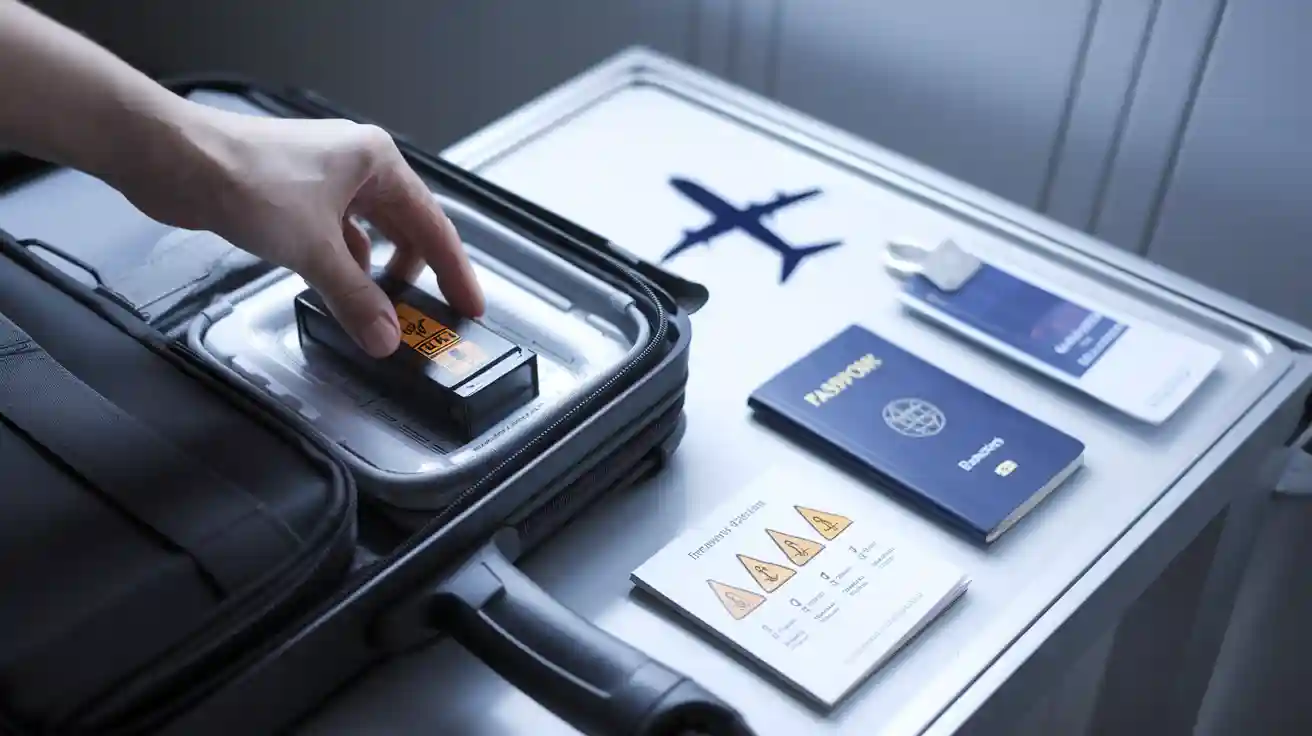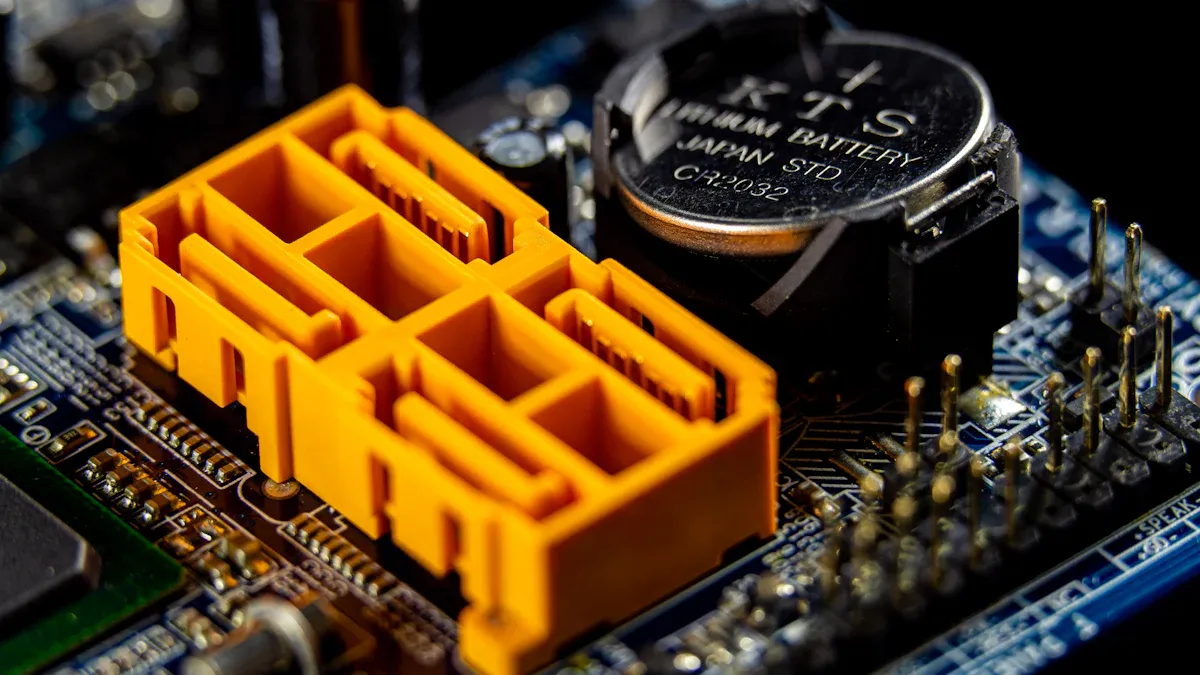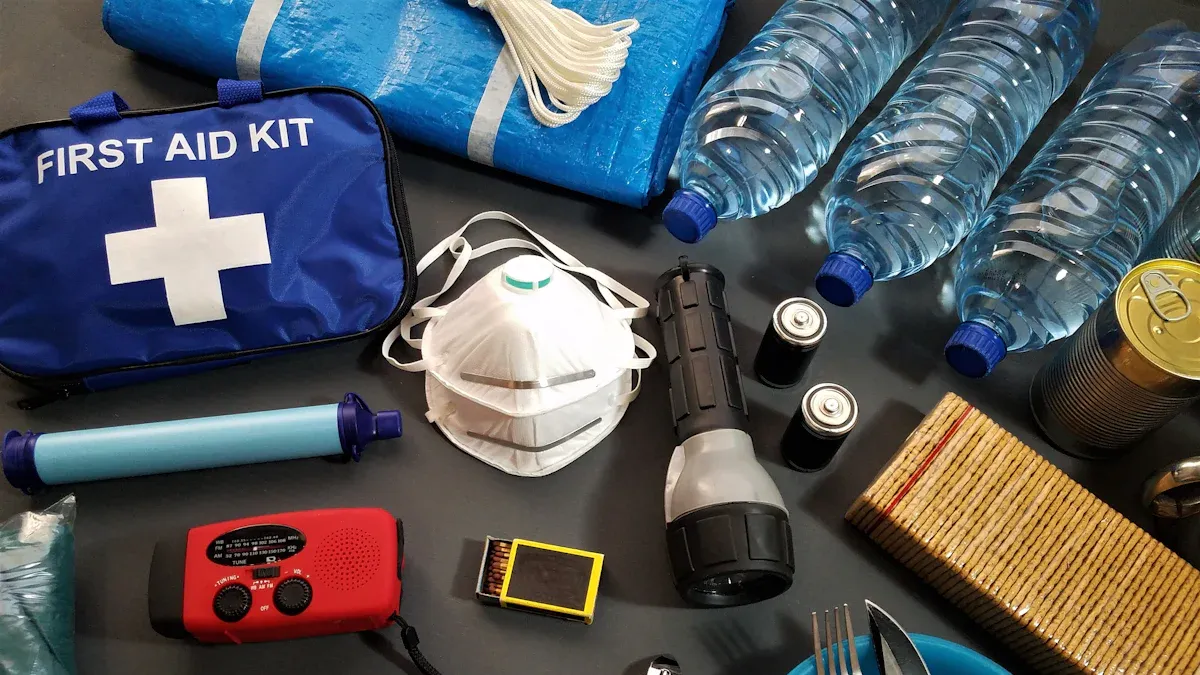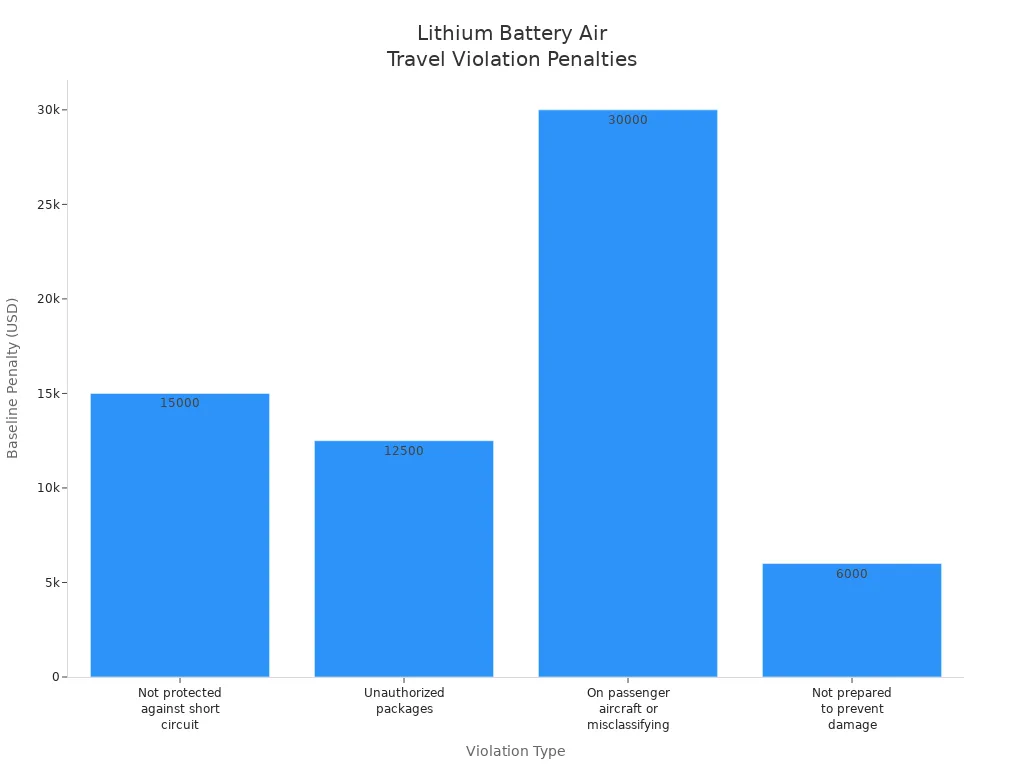
You need to pack lipo batteries and lithium-ion batteries correctly for air travel. Always place spare batteries and power banks in your carry-on, not in checked luggage. The FAA reported over 80 battery incidents on planes in 2024, often from lipo batteries causing smoke or fire. Air travel restrictions and rules require you to keep these batteries in carry-on luggage for safety. If you follow these steps, you help prevent accidents and can travel with confidence.
Air Travel Restrictions for LiPo Batteries
Carry-On vs. Checked Luggage
You must follow strict air travel restrictions when packing lipo batteries and lithium-ion batteries. The FAA and TSA have clear rules to keep everyone safe. You can carry devices with lithium-ion batteries in both carry-on and checked luggage. However, you must place all spare lipo batteries and lithium-ion batteries only in your carry-on. Never pack spare batteries in checked luggage. This rule exists because fires from lithium batteries are easier to control in the cabin than in the cargo hold.
小贴士 始终如一 protect spare batteries from short circuits. Use original packaging, tape the terminals, or place each battery in a separate pouch.
Here is a quick summary of the main rules:
- Devices with installed lithium-ion batteries can go in both carry-on and checked luggage.
- Spare lipo batteries and lithium-ion batteries must only go in carry-on luggage.
- Chargers with batteries installed must also be in your carry-on.
- Never pack spare batteries in checked luggage due to fire risk.
- Damaged or recalled batteries are not allowed on planes.
If you do not follow these air travel restrictions, you may face fines or even criminal charges. Security officers check for these items during screening. The FAA rules exist to protect you and other travelers.
Battery Size Limits
The FAA sets clear limits for the size of lithium-ion and lipo batteries you can bring on a plane. These limits use watt-hour (Wh) ratings. You need to check the label on your battery to find this number.
| Battery Watt-hour Rating | Carry-on Luggage Rules |
|---|---|
| Up to 100 Wh | Allowed without special permission |
| 101 Wh to 160 Wh | Allowed with airline approval; limited to two spare batteries per passenger; must be in carry-on luggage only |
| Above 160 Wh | Generally prohibited except specific exceptions (e.g., wheelchair batteries up to 300 Wh, with restrictions) |
Most consumer electronics, like phones, tablets, and cameras, use batteries under 100 Wh. You can bring these in your carry-on without special approval. If you have a battery between 101 Wh and 160 Wh, you need airline approval. You can only bring two of these larger batteries, and they must be in your carry-on luggage. Batteries over 160 Wh are not allowed unless they are for special equipment, such as wheelchairs, and even then, strict regulations apply.
Quantity Limits
You also need to follow quantity limits for spare lithium-ion and lipo batteries. For most small batteries under 100 Wh, you can bring up to 20 spares in your carry-on. If your batteries are between 101 Wh and 160 Wh, you can only bring two spares, and you must get airline approval first.
- Spare lithium-ion batteries under 100 Wh: up to 20 in carry-on luggage.
- Spare lithium-ion batteries between 101 Wh and 160 Wh: maximum of two per passenger, airline approval required.
- Spare batteries over 160 Wh: not allowed in carry-on or checked luggage.
- All spare batteries must be protected from damage and short circuits.
请注意: These quantity limits help prevent fire hazards and make it easier for crew members to respond if a battery overheats.
You must always follow these air travel restrictions and regulations. The FAA and TSA update their rules often, so check with your airline before you fly. By following these guidelines, you keep yourself and others safe and avoid legal trouble.
Packing Lithium-Ion and LiPo Batteries

Checking Watt-Hour Ratings
Before you pack lithium-ion or lipo batteries, you need to check the watt-hour rating. This rating tells you if your batteries meet air travel rules. Most lithium-ion batteries have the watt-hour rating printed on the label. If you cannot find it, look in the product manual or the battery’s safety data sheet. You can also calculate the watt-hour rating by multiplying the voltage by the amp-hour capacity. For example, if your battery says 3.7V and 2,000mAh, divide 2,000 by 1,000 to get 2Ah, then multiply by 3.7 to get 7.4Wh. If you still cannot find the rating, contact the battery manufacturer. Checking the watt-hour rating helps you follow airline and safety rules for lithium-ion batteries and lipo batteries.
Safe Packing Tips
You must pack lithium-ion batteries and lipo batteries safely to prevent short circuits and fire risks. Always inspect your batteries for damage, swelling, or overheating before you travel. Never bring damaged or recalled lithium batteries on a plane. Place each spare battery in your carry-on bag, not in checked luggage. Use the original packaging if you have it. If not, put each battery in a separate plastic bag or protective case. Cover the terminals with electrical tape to stop them from touching metal objects. Do not pack batteries with coins, keys, or other metal items. Keep devices powered off during takeoff and landing. If you see smoke, swelling, or smell something strange, tell a flight attendant right away.
小贴士 Use both a plastic bag and tape for extra protection, especially for batteries with exposed terminals.
Devices with Installed Batteries
You can bring devices with installed lithium-ion or lipo batteries in your carry-on or checked luggage. Spare lithium-ion batteries must stay in your carry-on. Never pack spare lithium batteries in checked bags. If your device has a removable battery, take it out and pack it as a spare. Do not bring damaged, defective, or recalled batteries. Dispose of damaged batteries before your trip or return recalled ones to the manufacturer. Smart bags with removable batteries are allowed, but you must remove the battery if you check the bag. Always follow airline rules for lithium-ion batteries and lipo batteries to keep everyone safe.
| 电池类型 | Carry-on Allowed | Checked Baggage Allowed |
|---|---|---|
| Lithium-ion (≤100 Wh) | Yes, in devices and as spares | Yes, only installed in devices |
| Lithium-ion (>100 Wh to 160 Wh) | Yes, max 2 spare batteries per person | Yes, only installed in devices |
| Lipo batteries | Yes, follow same rules as lithium-ion | Yes, only installed in devices |
Airline and International Variations
Airline Policies
Most airlines follow international regulations for transporting lithium-ion and lithium-polymer batteries. These rules help keep everyone safe. You will find that airlines use the same basic guidelines, but some have extra restrictions. For example, all U.S. airlines require you to carry spare batteries in your carry-on bag. You cannot put them in checked luggage. Some airlines, like Southwest, limit you to 20 spare batteries under 100 Wh, while others, like Frontier, only allow two. American Airlines lets you bring up to four spare batteries under 100 Wh and two between 100 and 160 Wh. Delta Air Lines uses similar rules.
Here is a table showing how airlines apply these policies:
| Aspect | Lithium-ion / Li-Polymer Batteries | 说明 |
|---|---|---|
| Classification | Non-Class 9 (small) or Class 9 (large) | Class 9 needs stricter packaging and labeling |
| Packaging Instructions | PI 965 (loose), PI 966/967 (in equipment) | Different rules for batteries in devices vs. spares |
| Passenger vs Cargo | Spares not allowed as cargo on passenger planes | Cargo Aircraft Only label for some shipments |
| State-of-Charge Limit | Max 30% SoC for some shipments | Applies to batteries shipped separately, not in devices |
| Labeling | CAUTION and Class 9 labels required | Ensures proper handling |
| Quantity Limits | Varies by airline and battery size | Most airlines limit spares in carry-on; shipping limits also apply |
| 安全措施 | Protect against short circuit, use strong packaging | Damaged batteries not allowed |
请注意: Always check your airline’s website before you fly. Some airlines have stricter rules than others.
International Flights
When you travel internationally, you must follow both your airline’s rules and the country’s regulations. Most countries use the International Air Transport Association (IATA) standards. These rules match U.S. guidelines in many ways. Both require you to carry spare lithium-ion batteries in your carry-on bag. You cannot put them in checked luggage. International regulations may ask for extra labeling or special packaging. Some countries, like the United Kingdom, use rules almost the same as the FAA. Others may have small differences in packaging or documentation.
- U.S. regulations come from the Department of Transportation and the FAA.
- International flights use IATA and United Nations rules.
- Both require you to protect batteries from short circuits and damage.
- Some countries may ask for extra paperwork or labels.
- Always check the rules for your destination before you pack.
🛫 If you fly to another country, check both your airline’s and the destination country’s rules for lithium-ion batteries. This helps you avoid problems at the airport.
Safety and Fire Prevention

Why Carry-On Matters
You play a key role in keeping everyone safe when you follow safety rules for lithium-ion and Li-Polymer batteries. Carrying these batteries in your carry-on bag is not just a rule—it is a proven way to reduce fire risk. Lithium batteries can overheat and start thermal runaway incidents, which create intense heat and flames. If a fire starts in the cargo hold, it may go unnoticed and overwhelm the plane’s fire suppression systems. In the cabin, flight attendants can spot problems quickly and use fire extinguishers or special containment bags. The FAA and TSA require you to keep spare batteries in your carry-on to reduce fire hazards and allow for a fast response. Proper packing in your carry-on also helps prevent short circuits, which are a leading cause of thermal runaway and fire.
小贴士 Always pack batteries so the terminals do not touch metal objects. Use original packaging or tape to insulate the terminals and reduce fire risk.
Responding to Incidents
You need to know what to do if a thermal runaway incident happens on a plane. Flight crews train to handle these emergencies, but you can help by staying calm and alerting the crew right away if you see smoke or smell something burning. Here are the main steps crews follow during thermal runaway incidents:
- Contain the fire immediately to stop it from spreading.
- Manage smoke, which is toxic and can make it hard to see.
- Use halon or dry chemical extinguishers to put out flames, but remember that these do not stop thermal runaway.
- Cool the battery or device with water or non-alcoholic liquids to stop the thermal reaction.
- Do not place the battery in a burn bag unless it is airtight, as trapped heat can make the thermal event worse.
- Crew members use protective equipment and emergency kits to stay safe.
- Continue cooling the device and monitor it, as thermal runaway incidents can flare up again.
You help reduce fire risk by following all safety instructions and reporting any signs of battery trouble. Airlines focus on crew training and readiness to handle thermal runaway incidents, which keeps everyone safer during flights.
Checklist and Resources
Pre-Flight Checklist
Before you head to the airport, use this checklist to make sure you pack your lithium-ion and Li-Polymer batteries safely and follow all air travel rules:
- Place all lithium-ion and Li-Polymer batteries in your carry-on bag. Never put spare batteries or external chargers in checked luggage.
- Cover battery terminals with non-conductive tape or use the original packaging. This step helps prevent short circuits.
- Power off all electronic devices. Protect switches so they do not turn on by accident during your trip.
- Check that each battery is under 100 watt hours. Count your batteries and make sure you do not exceed the allowed quantity.
- Avoid traveling with batteries that are fully charged. Keep them at a partial charge for extra safety.
- Inspect your batteries for damage or recall notices. Do not bring any battery that is damaged or recalled unless it has been repaired or replaced by the manufacturer.
- Place an identification tag inside your baggage. This tag helps you recover your bag if it gets lost.
- Review the latest FAA, TSA, and airline-specific rules for battery transport before you travel.
✅ Following this checklist helps you stay safe and avoid problems at airport security.
Official Guidelines
You can find the most reliable information about lithium battery air travel from these official sources:
- The U.S. Department of Transportation’s Hazardous Materials Regulations (HMR) explains how to pack, label, and handle lithium batteries.
- The Pipeline and Hazardous Materials Safety Administration (PHMSA) updates lithium battery transport rules to match international standards.
- The International Air Transport Association (IATA) publishes a Lithium Battery Guidance Document with detailed packing and labeling instructions.
- The Environmental Protection Agency (EPA) and Occupational Safety and Health Administration (OSHA) provide tips for safe battery recycling and disposal.
- Airlines and regulators require you to carry non-removable lithium batteries in the cabin if they exceed certain watt-hour or lithium metal limits.
- IATA offers training courses on shipping lithium batteries by air for those who need extra guidance.
ℹ️ Always check these resources before you fly. Rules can change, and staying informed keeps your trip smooth and safe.
You must pack batteries in your carry-on, protect terminals, and check watt-hour limits to follow FAA and airline rules. Never place damaged or spare batteries in checked luggage. Stay informed about changing regulations by reviewing airline and international policies before each trip.
Following these steps keeps you safe and avoids costly penalties.
常见问题
Can you bring LiPo batteries in checked luggage?
No, you cannot bring spare LiPo batteries in checked luggage. You must pack all spare lithium-ion and LiPo batteries in your carry-on bag. This rule helps prevent fires in the cargo hold.
How do you protect battery terminals when flying?
You can use electrical tape to cover the terminals. You may also use the original packaging or place each battery in a separate plastic bag. This step prevents short circuits and keeps your batteries safe.
What should you do if your battery looks damaged before a flight?
Do not pack or use any battery that looks swollen, cracked, or leaking. You should recycle damaged batteries at a proper facility. Airlines do not allow damaged or recalled batteries on planes.
Do you need airline approval for all lithium batteries?
You do not need approval for batteries under 100 Wh. For batteries between 101 Wh and 160 Wh, you must get airline approval. You cannot bring batteries over 160 Wh unless they are for special equipment, like wheelchairs.


